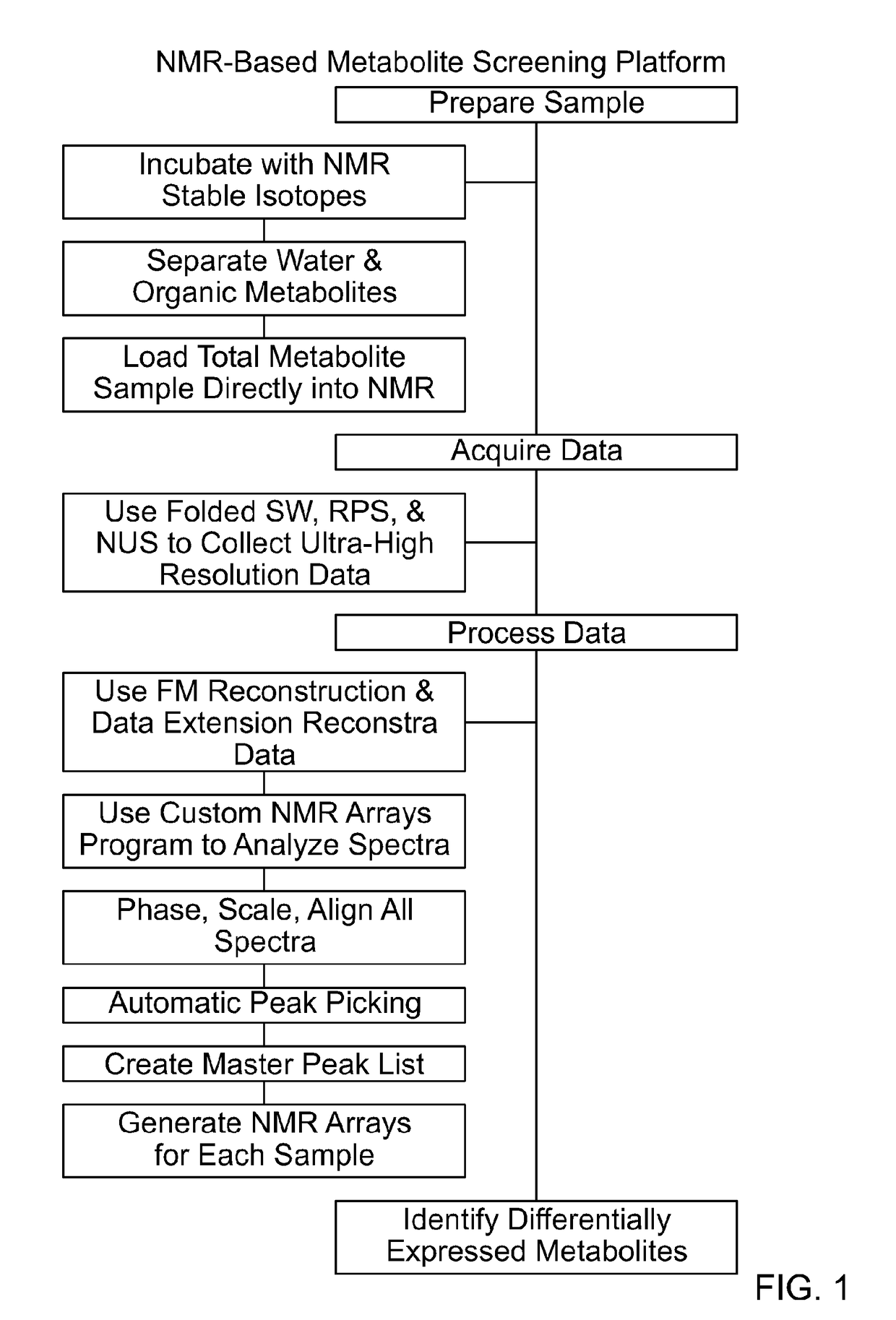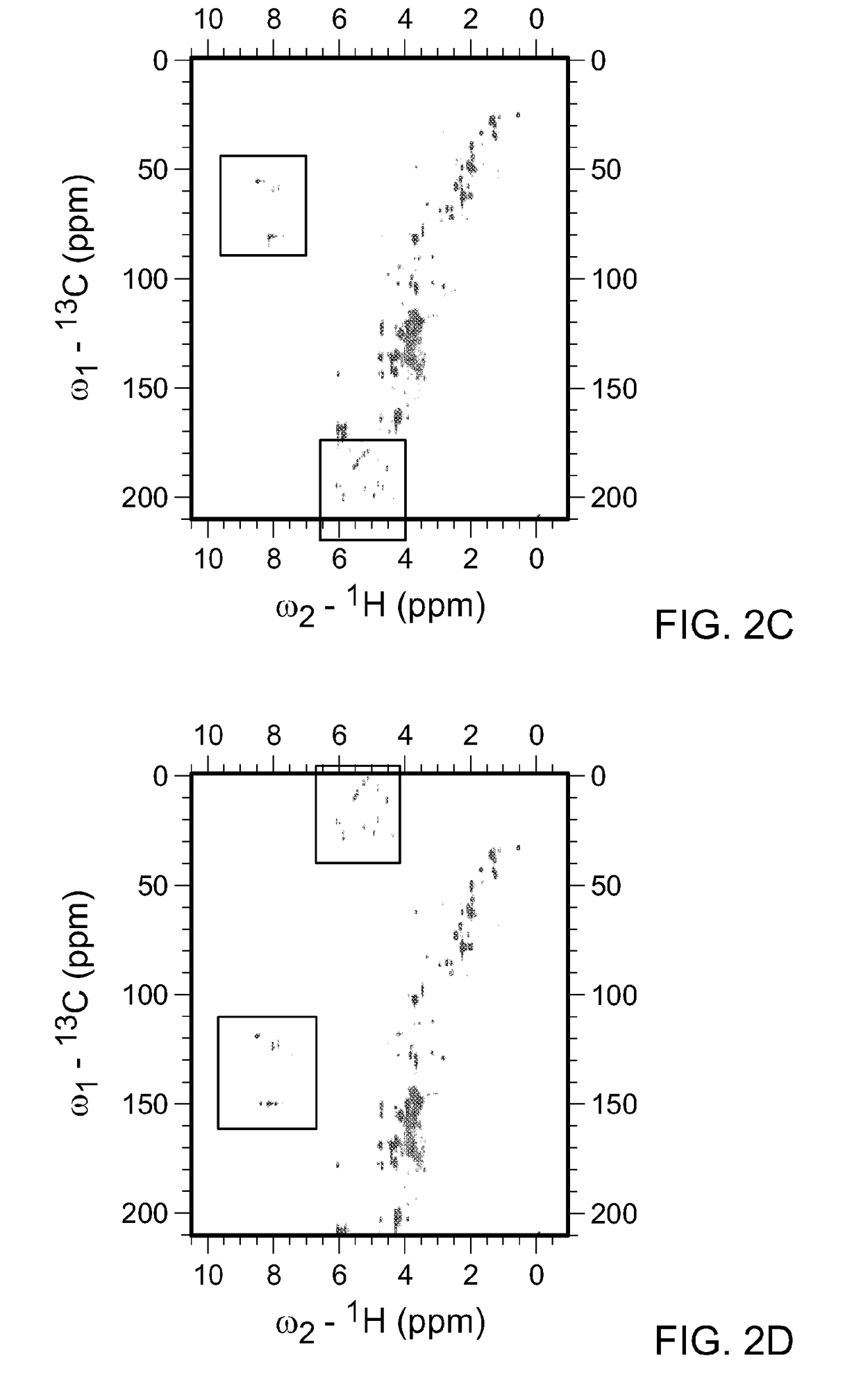NMR-based metabolite screening platform
a metabolite and platform technology, applied in the field of nmr-based metabolite screening platforms, can solve the problems of limiting analysis, not all metabolites, including nucleotide analogs and lipids, are easily ionizable, and cannot be detected via mass spectrometry, so as to improve the dynamic range data reconstruction, simplify statistical analysis, and improve the effect of nmr efficiency
- Summary
- Abstract
- Description
- Claims
- Application Information
AI Technical Summary
Benefits of technology
Problems solved by technology
Method used
Image
Examples
example 1
Methodology for the Screening Platform Utilizing NMR
[0098]Preparation of Biological Sample:
[0099]FIG. 1 provides an overall description of the platform. Approximately 20 million cells were used for each sample (however it is possible to use as few as 2 million). Before harvesting, 13C-labeled precursors (glucose and glutamine in these examples) were added directly to the media and allowed to incubate for a user-defined amount of a time and in this case 4 hrs. After aspirating the media and washing two times with phosphate-buffered saline (PBS), the cells were again counted and collected. An equal number of cells with no label were also harvested to serve as a 13C background control. Cells were lysed by the addition of ice-cold methanol, and an aqueous extraction was performed by adding equal parts water and chloroform. After centrifugation the water soluble and organic metabolites were separately collected, dried, and stored until ready to be further analyzed. No additional purifica...
example 2
Rapid Ultra High Resolution NMR Data Acquisition
[0103]Folding the Spectra:
[0104]While the aforementioned sample preparation alleviated the physical demands on the amount sample, the long acquisition time required to record high resolution 2D NMR spectroscopy was still a concern. To combat this, a multi-prong approach was taken: “folding” the spectra width, using random phase sampling (RPS), implementing non-uniform sampling (NUS) techniques and data extension in the analysis.
[0105]As described above, the spectral width (sw) is the range of frequencies over which NMR signals are to be detected. Metabolite mixtures contain diverse molecules, and the spectral width necessary to cover all potential carbon chemical shifts spans over −220 ppm. In FIG. 2A, the HSQC spectra for all water soluble metabolites in KRAS mutant pancreatic cancer cells is shown. In this instance the 13C-sw spans 220 ppm and a total 1024 points were collected. By solving the equation, resolution=SW / TD (where TD is ...
example 3
Analyzing Metabolite NMR Data
[0113]NMR Analysis:
[0114]As summarized in FIG. 4, a custom “NMR Metabolite Array” program was created to automate the NMR analysis process using the method herein described. First, the spectra are phased, aligned, and scaled with an internal control. 1 mM 4,4-dimethyl-4-silapentane-1-sulfonic acid (DSS) was added into each sample, and its concentration was used as a reference to allow relative quantification comparisons between samples to be made. We created an automatic peak picking program to generate peak lists for each sample, where each resonance peak was converted into an X, Y coordinate with an intensity value. Next we created a “MASTER PEAK LIST” program that generates a “master” look up table for all the resonances in the spectra under investigation and was subsequently run.
[0115]In short, this program reads all X, Y points from the individual peak list files, removes duplicates within defined tolerances and writes the resulting set of peaks to ...
PUM
| Property | Measurement | Unit |
|---|---|---|
| time | aaaaa | aaaaa |
| concentration | aaaaa | aaaaa |
| chemical shifts | aaaaa | aaaaa |
Abstract
Description
Claims
Application Information
 Login to View More
Login to View More - R&D
- Intellectual Property
- Life Sciences
- Materials
- Tech Scout
- Unparalleled Data Quality
- Higher Quality Content
- 60% Fewer Hallucinations
Browse by: Latest US Patents, China's latest patents, Technical Efficacy Thesaurus, Application Domain, Technology Topic, Popular Technical Reports.
© 2025 PatSnap. All rights reserved.Legal|Privacy policy|Modern Slavery Act Transparency Statement|Sitemap|About US| Contact US: help@patsnap.com



